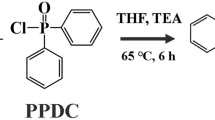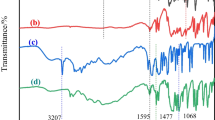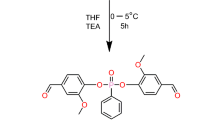Abstract
Combining bio-based functional reagents and biopolymers has become a solution to address the needs of sustainability, health, and safety as society has grown. This study developed a waterproof and intumescent flame retardant system for epoxy resin (EP) by combining hexachlorocyclotriphosphazene and melamine with vanillin, synthesizing a ternary polymer flame retardant (HCPVM), combining carbon and gas sources, and using piperazine pyrophosphate (PAPP) as an acid source. The test results showed that HCPVM could participate in the curing reaction of EP and improve the mechanical properties of EP material. At the same time, the flame retardancy and water resistance of the material have been significantly improved. The peak heat release rate (PHRR) of EP/3.5 PAPP/0.5 HCPVM was 65.43% lower than that of pure EP. Additionally, the system's LOI and UL-94 did not significantly change after five days of boiling. In summary, this study's waterproof bio-based intumescent flame retardant solution broadens the application possibilities for EP.
Graphical abstract











Similar content being viewed by others
References
Gao M, Wu W, Yan Y. Thermal degradation and flame retardancy of epoxy resins containing intumescent flame retardant. J Therm Anal Calorim. 2009;95(2):605–8. https://doi.org/10.1007/s10973-008-9766-8.
Jin FL, Li X, Park SJ. Synthesis and application of epoxy resins: a review. J Ind Eng Chem. 2015;29:1–11. https://doi.org/10.1016/j.jiec.2015.03.026.
Chen R, Luo ZJ, Yu XJ, Tang H, Zhou Y, Zhou H. Synthesis of chitosan-based flame retardant and its fire resistance in epoxy resin. Carbohydr Polym. 2020;245:7. https://doi.org/10.1016/j.carbpol.2020.116530.
Huo SQ, Yang S, Wang J, et al. A liquid phosphorus-containing imidazole derivative as flame-retardant curing agent for epoxy resin with enhanced thermal latency, mechanical, and flame-retardant performances. J Hazard Mater. 2020;386:121984. https://doi.org/10.1016/j.jhazmat.2019.121984.
Xu Y, Li J, Shen R, et al. Experimental study on the synergistic flame retardant effect of bio-based magnesium phytate and rice husk ash on epoxy resins. J Therm Anal Calorim. 2021;146(1):153–64. https://doi.org/10.1007/s10973-020-10420-8.
Song Q, Wu H, Liu H, Han X, Qu H, Xu J. Synergistic flame-retardant effects of ammonium polyphosphate and AC-Fe2O3 in epoxy resin. J Therm Anal Calorim. 2019;138(2):1259–67. https://doi.org/10.1007/s10973-019-08247-z.
Enescu D, Frache A, Lavaselli M, Monticelli O, Marino F. Novel phosphorous-nitrogen intumescent flame retardant system: its effects on flame retardancy and thermal properties of polypropylene. Polym Degrad Stab. 2013;98(1):297–305. https://doi.org/10.1016/j.polymdegradstab.2012.09.012.
Ke CH, Li J, Fang KY, Zhu QL, Zhu J, Yan Q, et al. Synergistic effect between a novel hyperbranched charring agent and ammonium polyphosphate on the flame retardant and anti-dripping properties of polylactide. Polym Degrad Stab. 2010;95(5):763–70. https://doi.org/10.1016/j.polymdegradstab.2012.09.012.
Ferry L, Dorez G, Taguet A, Otazaghine B, Lopez-Cuesta JM. Chemical modification of lignin by phosphorus molecules to improve the fire behavior of polybutylene succinate. Polym Degrad Stab. 2015;113:135–43. https://doi.org/10.1016/j.polymdegradstab.2014.12.015.
Feng JX, Su SP, Zhu J. An intumescent flame retardant system using β-cyclodextrin as a carbon source in polylactic acid (PLA). Polym Adv Technol. 2011;22(7):1115–22. https://doi.org/10.1002/pat.1954.
Xie F, Wang YZ, Yang B, Liu Y. A novel intumescent flame-retardant polyethylene system. Macromol Mater Eng. 2006;291(3):247–53. https://doi.org/10.1002/mame.200500356.
Ma D, Li J. Synthesis of a bio-based triazine derivative and its effects on flame retardancy of polypropylene composites. J Appl Polym. 2020;137(1):47367. https://doi.org/10.1002/app.47367.
Song KP, Wang YJ, Ruan F, Liu JP, Li NH, Li XL. Effects of a macromolecule spirocyclic inflatable flame retardant on the thermal and flame retardant properties of epoxy resin. Polym-Basel. 2020;12(1):132. https://doi.org/10.3390/polym12010132.
Wang J, Guo Y, Zhao SP, Huang RY, Kong XJ. A novel intumescent flame retardant imparts high flame retardancy to epoxy resin. Polym Adv Technol. 2020;31(5):932–40. https://doi.org/10.1002/pat.4827.
Xiao X, Zhai JG, Chen T, Mai YY, Hu S, Ye W, et al. Flame retardant properties of polyamide 6 with piperazine pyrophosphate. Plast Rubber Compos. 2017;46(5):193–9. https://doi.org/10.1080/14658011.2017.1308068.
Yuan Z, Wen H, Liu Y, Wang Q. Synergy between piperazine pyrophosphate and aluminum diethylphosphinate in flame retarded acrylonitrile-butadiene-styrene copolymer. Polym Degrad Stab. 2021;190:109639. https://doi.org/10.1016/j.polymdegradstab.2021.109639.
Li SS, Liu Y, Liu YS, Wan Q. Synergistic effect of piperazine pyrophosphate and epoxy-octavinyl silsesquioxane on flame retardancy and mechanical properties of epoxy resin. Compos Part B Eng. 2021;223:109115. https://doi.org/10.1016/j.compositesb.2021.109115.
Xiao F, Fontaine G, Bourbigot S. Improvement of flame retardancy and antidripping properties of intumescent polybutylene succinate combining piperazine pyrophosphate and zinc borate. ACS Appl Polym Mater. 2022;4(3):1911–21. https://doi.org/10.1021/acsapm.1c01755.
Chu FK, Ma C, Zhang T, Xu ZM, Mu XW, Cai W, et al. Renewable vanillin-based flame retardant toughening agent with ultra-low phosphorus loading for the fabrication of high-performance epoxy thermoset. Compos Part B Eng. 2020;190:107925. https://doi.org/10.1016/j.compositesb.2020.107925.
Huang YS, Ma TT, Wang QW, Guo CG. Synthesis of biobased flame-retardant carboxylic acid curing agent and application in wood surface coating. ACS Sustain Chem Eng. 2019;7(17):14727–38. https://doi.org/10.1021/acssuschemeng.9b02645.
Zhang K, Wu H, Wang T, et al. Flame-retardant effect of cross-linked phosphazene derivatives and pentaerythritol derivatives on polypropylene. J Therm Anal Calorim. 2021;145(6):3067–75. https://doi.org/10.1007/s10973-020-09898-z.
Aljamal A, Marosi G, Szolnoki B. Investigation of the modes of action for phosphorous flame retardants in a fully waterborne sugar-based epoxy resin. J Therm Anal Calorim. 2023;148(2):281–92. https://doi.org/10.1007/s10973-022-11736-3.
Wang JY, Xu B, Wang XD, Liu YT. A phosphorous-based bi-functional flame retardant for rigid polyurethane foam. Polym Degrad Stab. 2021;186:109516. https://doi.org/10.1016/j.polymdegradstab.2021.109516.
Shariatinia Z, Javeri N, Shekarriz S. Flame retardant cotton fibers produced using novel synthesized halogen-free phosphoramide nanoparticles. Carbohydr Polym. 2015;118:183–98. https://doi.org/10.1016/j.carbpol.2014.11.039.
Liu R, Wang XD. Synthesis, characterization, thermal properties and flame retardancy of a novel nonflammable phosphazene-based epoxy resin. Polym Degrad Stab. 2009;94(4):617–24. https://doi.org/10.1016/j.polymdegradstab.2009.01.008.
Alhumaimess MS, Alsohaimi IH, Alqadami AA, et al. Recyclable glutaraldehyde cross-linked polymeric tannin to sequester hexavalent uranium from aqueous solution. J Mol Liq. 2019;281:29–38. https://doi.org/10.1016/j.molliq.2019.02.040.
Dai SQ, Chen Y, Yang JX, He F, Chen C, Xie HF. Surface treatment of nanozirconia fillers to strengthen dental bisphenol A-Glycidyl Methacrylate-Based resin composites. Int J Nanomed. 2019;14:9185–97. https://doi.org/10.2147/IJN.S223392.
Martinez-Iniesta AD, Morelos-Gomez A, Munoz-Sandoval E, Lopez-Urias F. Nitrogen-phosphorus doped graphitic nano onion-like structures: experimental and theoretical studies. RSC Adv. 2021;11(5):2793–803. https://doi.org/10.1039/D0RA10019F.
Cai H, Han DY, Wang XN, et al. High specific surface area defective g-C3N4 nanosheets with enhanced photocatalytic activity prepared by using glyoxylic acid mediated melamine. Mater Chem Phys. 2021;256(7):123755. https://doi.org/10.1016/j.matchemphys.2020.123755.
Pappas GS, Ferrari S, Huang XB, Bhagat R, Haddleton DM, Wan CY. Heteroatom Doped-Carbon nanospheres as anodes in lithium ion batteries. Materials. 2016;9(1):35. https://doi.org/10.3390/ma9010035.
Li P, Wang B, Liu YY, et al. Fully bio-based coating from chitosan and phytate for fire-safety and antibacterial cotton fabrics. Carbohydr Polym. 2020;237:116173. https://doi.org/10.1016/j.carbpol.2020.116173.
Zhang XQ, Xu HB, Fan XY. Grafting of amine-capped cross-linked polyphosphazenes onto carbon fiber surfaces: a novel coupling agent for fiber reinforced composites. RSC Adv. 2014;4(24):12198–205. https://doi.org/10.1039/C3RA47213B.
Salaun F, Vroman I. Influence of core materials on thermal properties of melamine-formaldehyde microcapsules. Eur Polym J. 2008;44(3):849–60. https://doi.org/10.1016/j.eurpolymj.2007.11.018.
Price D, Yan L, Hull TR. Burning behaviour of foam/cotton fabric combinations in the cone calorimeter. Polym Degrad Stab. 2002;77(2):213–20. https://doi.org/10.1016/s0141-3910(02)00036-8.
Ding H, Huang K, Li S, Xu L, Xia J, Li M. Synthesis of a novel phosphorus and nitrogen-containing bio-based polyol and its application in flame retardant polyurethane foam. J Anal Appl Pyrol. 2017;128:102–13. https://doi.org/10.1016/j.jaap.2017.10.020.
Zhang H, Meng D, Wang W, et al. Fabrication of phytic acid embellished kaolinite and its effect on the flame retardancy and thermal stability of ethylene vinyl acetate composites. J Appl Polym Sci. 2021;138(46):51364. https://doi.org/10.1002/app.51364.
Chen X, Zhuo J, Jiao C. Thermal degradation characteristics of flame retardant polylactide using TG-IR. Polym Degrad Stab. 2012;97(11):2143–7. https://doi.org/10.1016/j.polymdegradstab.2012.08.016.
Xing W, Zhang P, Song L, Wang X, Hu Y. Effects of alpha-zirconium phosphate on thermal degradation and flame retardancy of transparent intumescent fire protective coating. Mater Res Bull. 2014;49:1–6. https://doi.org/10.1016/j.materresbull.2013.08.033.
Cai W, Wang J, Pan Y, et al. Mussel-inspired functionalization of electrochemically exfoliated graphene: Based on self-polymerization of dopamine and its suppression effect on the fire hazards and smoke toxicity of thermoplastic polyurethane. J Hazard Mater. 2018;352:57–69. https://doi.org/10.1016/j.jhazmat.2018.03.021.
Acknowledgements
This work was supported by the National Natural Science Foundation Project [Grant Numbers 52273072]; the multidisciplinary research project of Hebei University [Grant Numbers DXK202003]; Key research and development projects of Hebei Province [Grant Numbers 19211205D]; Open project of Hebei Provincial key laboratory of hazardous chemicals safety and control technology [Grant Numbers 20211204-3].
Author information
Authors and Affiliations
Corresponding authors
Additional information
Publisher's Note
Springer Nature remains neutral with regard to jurisdictional claims in published maps and institutional affiliations.
Rights and permissions
Springer Nature or its licensor (e.g. a society or other partner) holds exclusive rights to this article under a publishing agreement with the author(s) or other rightsholder(s); author self-archiving of the accepted manuscript version of this article is solely governed by the terms of such publishing agreement and applicable law.
About this article
Cite this article
Cui, Y., Wu, H., Zhang, M. et al. A ternary polymer flame retardant and its synergistic flame retardant effect with piperazine pyrophosphate in EP. J Therm Anal Calorim 148, 13837–13850 (2023). https://doi.org/10.1007/s10973-023-12568-5
Received:
Accepted:
Published:
Issue Date:
DOI: https://doi.org/10.1007/s10973-023-12568-5




